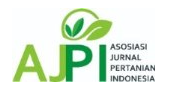Determination of Protein Content Protein from various growing places of Pineapple (Ananas comosus Merr.)
DOI:
https://doi.org/10.58794/juragan.v2i1.828Keywords:
pineapple, protein, growing placeAbstract
Pineapple is a special plant that has a sweet and sour taste and has various benefits. Based on where the pineapple grows, the taste will vary. The aim of this research is to determine the protein content of pineapple based on where it grows. This research method is to determine Lowry protein levels using spectrophotometry. The results of this research were measurements of protein levels in peat areas, the protein concentration was 48.14 µg/mL. After conversion by dilution, the volume used resulted in a sample weight of 0.019 grams. When converted to a sampling weight of 80 grams, the sample weight in percent is 0.024%. Meanwhile, when measuring in a mountainous environment, a level of 40.99 µg/mL was obtained, this is equivalent to a sample weight of 0.016 grams, when divided by the sampling weight of 80 grams, a level of 0.021% w/w was obtained. When sampling was carried out in the lowlands, the protein level obtained was 45.39 µg/mL. So the protein obtained is 0.018 grams, when you calculate the % weight per weight you get a level of 0.022%. The conclusion of this research is that the highest protein content is pineapple that grows in a peat environment.
References
Agustian D, Ginting Y, Timotiwu P and Widagdo S (2020) ‘TINGKAT TOLERANSI TANAMAN NANAS (Ananas comosus [L] Merr.) TERHADAP KONSENTRASI Fe PADA MEDIA HIDROPONIK’, Jurnal Agrotek Tropika, 8:485, doi:10.23960/jat.v8i3.4467.
Amir F, Dermiyati D, Ratih Dirmawati S and Arif S (2023) ‘PENGARUH MASA SIMPAN PUPUK HAYATI BERISI ISOLAT BAKTERI TERPILIH DARI RIMPANG NANAS DAN TANDAN KOSONG KELAPA SAWIT TERHADAP PERTUMBUHAN DAN PRODUKSI TANAMAN MENTIMUN (Cucumis sativus L.)’, Jurnal Agrotek Tropika, 11, doi:10.23960/jat.v11i3.7522.
Febriant S, Dermiyati D, Suharjo R, Yusnaini S and Niswati A (2024) ‘PENGARUH KOMBINASI KONSORSIUM BAKTERI DARI RIMPANG NANAS DAN TANDAN KOSONG KELAPA SAWIT (TKKS) DENGAN PUPUK ORGANONITROFOS TERHADAP PERTUMBUHAN DAN PRODUKSI TANAMAN BUNGA KOL (Brassica oleracea L.)’, Jurnal Agrotek Tropika, 12:174, doi:10.23960/jat.v12i1.8551.
Firmansyah D (2020) ‘Identifikasi Gugus Hidroksil dan Karbonil dalam Senyawa Organik Pada Tanaman Daun Nanas’, SainsTech Innovation Journal, 3:49–53, doi:10.37824/sij.v3i1.2020.226.
Joni J (1970) ‘KERAGAMAN MORFOLOGI TANAMAN NANAS( ANANAS COMOSUS (L) MERR) DI KABUPATEN INDRAGIRI HILIR’, JURNAL AGRO INDRAGIRI, 4:34–38, doi:10.32520/jai.v4i1.1050.
Khaki PS, Feroz A, Amin F, Rehman M, Bhat W and Bano B (2016) ‘Structural and functional studies on a variant of cystatin purified from brain of Capra hircus’, Journal of Biomolecular Structure and Dynamics, 35:1–62, doi:10.1080/07391102.2016.1191375.
Kusuma B, Supeno B and Haryanto H (2023) ‘Studi Keragaman Hama Kutu Putih Pada Batang Tanaman Nanas (Ananas comosus L.) Di Pembibitan Green House Daerah Yagaji Prefektur Okinawa Jepang’, Jurnal Ilmiah Mahasiswa Agrokomplek, 2:222–227, doi:10.29303/jima.v2i2.2623.
Lestari G and Fitri R (2019) ‘UJI DAYA HAMBAT EKSTRAK BUAH NANAS (Ananas comosus. L) TERHADAP BAKTERI ESCHERICHIA COLI’, Jurnal Ilmiah Pharmacy, 6:58–66, doi:10.52161/jiphar.v6i1.9.
M.Si M, Budi D, Maharani S and Rahardja BS (2023) ‘Pengaruh Suplementasi Enzim Bromelain Terhadap Performa Pertumbuhan Belut (Anguilla Bicolor)’, Journal of Aquaculture Science, 8:40–48, doi:10.31093/joas.v8i1.274.
Mahardika M and Susanto A (2022) ‘PENDAMPINGAN PENINGKATAN KETERAMPILAN PEMBUATAN EKSTRAK KULIT NANAS MENJADI PERMEN JELLI DI SMK MUHAMMADIYAH LEBAKSIU’, JMM (Jurnal Masyarakat Mandiri), 6, doi:10.31764/jmm.v6i5.10190.
Nuraini N, Wahyuni T and Muzammil M (2022) ‘Karakterisasi Beberapa Aksesi Tanaman Nanas Lokal dalam Upaya Pelestarian Sumber Daya Genetik di Bangka Belitung’, Proceedings Series on Physical & Formal Sciences, 4:128–136, doi:10.30595/pspfs.v4i.493.
Pamukas N, Mulyadi, Putra I, Asiah N, Adelina and Kairoa W (2022) ‘Effects of Bromealin on Digestive Enzyme Activities and Growth Performance of Asian Redtail Catfish (Hemibragus Nemurus)’, IOP Conference Series: Earth and Environmental Science, 1118:12003, doi:10.1088/1755-1315/1118/1/012003.
Parmiati P, Surachman S and Asnawati A (2023) ‘PENGARUH BOKASI KULIT NANAS DAN PUPUK NPK TERHADAP PERTUMBUHAN DAN HASIL TANAMAN TERUNG PADA TANAH ALUVIAL’, Jurnal Sains Pertanian Equator, 12:276, doi:10.26418/jspe.v12i2.62876.
Permatasari D, Muslihah Z, Handriyanti R, Saputri D and Trisiana A (2020) ‘ANALISIS ES KRIM HERBAL MELALUI SIFAT KIMIA (KADAR AIR, KADAR PROTEIN TERLARUT dan KADAR GULA TOTAL) dan SIFAT FISIK (UJI ORGANOLEPTIK)’, Jurnal Ilmu dan Teknologi Kesehatan, 11, doi:10.33666/jitk.v11i1.273.
Prasetyo H, Wijana G and Darmawati I (2023) ‘Inventarisasi dan Karakterisasi Morfologi dan Agronomi Tanaman Nanas (Ananas comosus (L.) Merr) pada Beberapa Sentra Produksi di Pulau Jawa, Indonesia’, Agro Bali : Agricultural Journal, 6:405–412, doi:10.37637/ab.v6i2.1222.
Rosita H and Regar A (2022) ‘PEMANFAATAN LIMBAH KULIT NANAS DAN ECENG GONDOK SEBAGAI PUPUK ORGANIK CAIR TERHADAP PERTUMBUHAN DAN HASIL TANAMAN KANGKUNG DARAT (Ipomoea reptans Poir.)’, Berkala Ilmiah Pertanian, 5:110, doi:10.19184/bip.v5i2.29055.
Tahir M, Muflihunna A and Syafrianti S (2017) ‘Penentuan Kadar Fenolik Total Ekstrak Etanol Daun Nilam (Pogostemon Cablin Benth.) Dengan Metode Spektrofotometri Uv-Vis’, Jurnal Fitofarmaka Indonesia, 4:215–218, doi:10.33096/jffi.v4i1.231.
Tamsar K, Kardhinata E and Lubis K (2022) ‘Identifkasi Karakter Morfologi Tanaman Nanas (Ananas comosus (L.) Merr) Di Kabupaten Simalungun Provinsi Sumatera Utara’, Jurnal Online Agroekoteknologi, 10:1–9, doi:10.32734/joa.v10i2.8552.
Tirta Adhiguna R (2021) ‘KARAKTERISTIK BRIKET DAUN DAN BATANG DARI TANAMAN NANAS MENGGUNAKAN PEREKAT ALAMI LATEKS’, Jurnal Technopreneur (JTech), 9:110–115, doi:10.30869/jtech.v9i2.781.
Tuhuteru S, Rumbiak R, Pumoko P, Kossay T and Yikwa Y (2022) ‘Perbandingan Efektifitas Mikroorganisme Lokal Nanas dan Batang Pisang terhadap Pertumbuhan Tanaman Jagung Manis di Wamena’, Jurnal Agronomi Indonesia (Indonesian Journal of Agronomy), 49:288–294, doi:10.24831/jai.v49i3.36591.
Tusi A, Rosadi B and Triana M (2012) ‘Pendugaan Kebutuhan Air Tanaman Nanas (Ananas Comosus l. Merr) Menggunakan Model Cropwat’, Jurnal Irigasi, 7:43, doi:10.31028/ji.v7.i1.43-51.
Wigel W, Basri B and Khairat U (2023) ‘Penerapan Metode Dempster Shafer Untuk Diagnosa Penyakit pada Tanaman Nanas’, Journal Peqguruang: Conference Series, 5:844, doi:10.35329/jp.v5i2.4352.
Yantika R, Mulqie L and Suwendar (2022) ‘Kajian Pustaka Aktivitas Antibakteri dari Tanaman Nanas (Ananas Comosus L. Merr) terhadap Bakteri Escherichia Coli dan Pseudomonas Aeruginosa’, Bandung Conference Series: Pharmacy, 2, doi:10.29313/bcsp.v2i2.4766.
Zakaria Z and Qurrota S (2024) ‘IDENTIFIKASI AKTIVITAS ENZIM NANAS (Ananas comosus) DAN PEPAYA (Carica papaya) PADA AGAR-AGAR DAN GELATIN’, JURNAL REDOKS : JURNAL PENDIDIKAN KIMIA DAN ILMU KIMIA, 7:26–34, doi:10.33627/re.v7i1.1634.
Zohriah H, Astiko W and Jaya K (2023) ‘Analisis Pembibitan Nursery Tanaman Nanas di Japan Agriculture Cooperatives Okinawa’, Jurnal Ilmiah Mahasiswa Agrokomplek, 2:171–177, doi:10.29303/jima.v2i1.2337.









